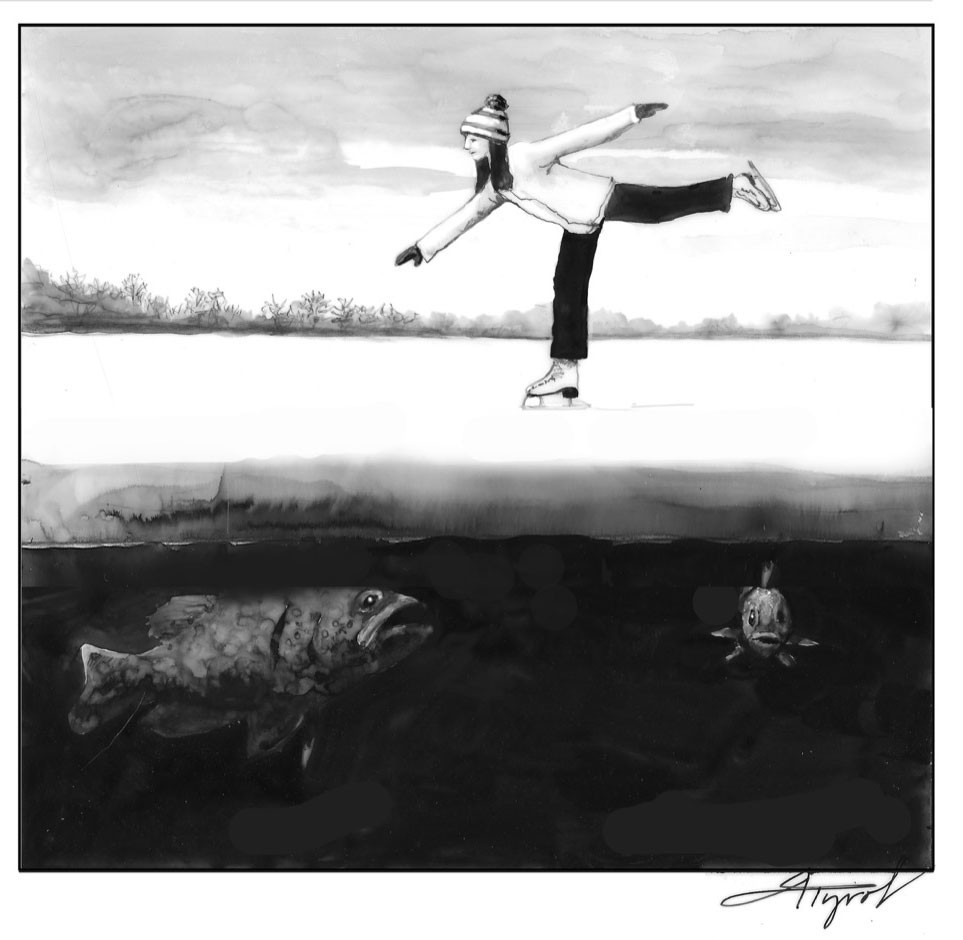
When I’m skiing or skating across a pond, I observe the shoreline, surrounding hills, islands, maybe a woodpecker or blue jay winging its way to the opposite shore. I look up at the sky, the clouds, swirling snowflakes. But there is a world beneath my feet that I don’t see, in what Henry David Thoreau called “the quiet parlor of the fishes.”
Beneath a layer of ice up to three feet thick, fish, reptiles, amphibians, and tiny invertebrates are going about their winter business. For most of these creatures, this means slowing their metabolism down to survive with reduced light and oxygen. They move less, eat less, and breathe more slowly than in warmer months.
Out of sight, out of mind is not the case if you’re an ice fisherman, of course. Fish remain active, although some species slow down. In the winter, warm water species such as bass move to deeper parts of the lake, where the water is warmest (about 39 degrees Fahrenheit). They stay relatively still, conserving energy and relying on fat stores they accumulated in the fall. Cold-water species such as trout, however, thrive in the cold water. In summer they like the chilly depths, but in winter they travel all over the lake. Cusk, a native species of larger lakes, actually spawn under the ice. (Cusk is a member of the cod family, also called burbot, eelpout, ling, and for some obscure reason, lawyer.) A favorite prey of cusk is crayfish, which are also active under the ice.
While we’re skating around on the ice, turtles aren’t doing much at all. As the water temperature goes down, the turtle’s body temperature and metabolism do, too. Turtles lie in the mud or on top of it, barely breathing. During their winter dormancy (sometimes called brumation, as opposed to mammalian hibernation), they absorb oxygen from the water through an orifice called the cloaca. Eastern painted turtles can live for extended periods without oxygen, and their heartbeats can slow to as few as one beat every 8-10 minutes.
They do move around, though. Turtle expert and author David Carroll, who has observed turtles for 60 years, says, “I’ve seen a spotted turtle moving under ice that’s as clear as a window. It’s a curious thing, because they like to be dug in to avoid otters and other predators.” Snapping turtles also are spotted moving beneath the ice, he says. “They can move in water that’s an eyelash above freezing.”
Another creature moving in the wintry water is the Eastern red-spotted newt. The orange salamanders we see in damp woodlands and on wet roads in summer are the juvenile stage of this amphibian. Red-spotted newts spend their first year in the water as larvae, using gills to breathe. For the next few years they are terrestrial, breathing through lungs and surviving winter by hibernating under leaves, rocks, and logs. As adults, they return to the water and turn olive green, with tiny black dots and a row of larger red-orange spots. Newts spend the winter resting on the lake bottom, swimming in short bursts, dining on insect larvae, and sometimes moving up to swallow a trapped air bubble just beneath the ice. If you find an ice-free area, you might see a bunch of them. Aggregations of newts around holes in the ice in springtime have been known to contain up to 100 individuals.
Frogs rest on the bottom of the pond, partially covered by leaf litter and mud. They don’t burrow in completely, or they’d suffocate. Even with drastically reduced metabolism, they need some oxygen. They get it by absorbing it through their skin. Because of the skin’s large surface area, they manage to take up enough oxygen and eliminate enough carbon dioxide to survive. Adult bullfrogs and green frogs sometimes swim slowly beneath the ice. In their tadpole stage, bullfrogs are active all winter. Bullfrogs take two or three years to mature, so tadpoles can be fairly large—a substantial meal for a crayfish, trout, or red-spotted newt.
There is plenty of life on a miniature scale, too. Dragonflies, mayflies, caddisflies, stoneflies, and other insects overwinter as nymphs, floating along or crawling on rocks. Whirligig beetles swim slowly or crawl on the underside of the ice. There are gazillions of tiny crustaceans such as fairy shrimp, freshwater shrimp, water fleas, cyclops, and copepods, which feed on dying algae and plant matter.
I can picture Thoreau stretched out on the ice of Walden Pond, checking out what’s going on beneath. I’ve done the same, usually seeing only tiny white bubbles. But I know that whether I see it or not, the “parlor of the fishes” is teeming with life.


Discussion *